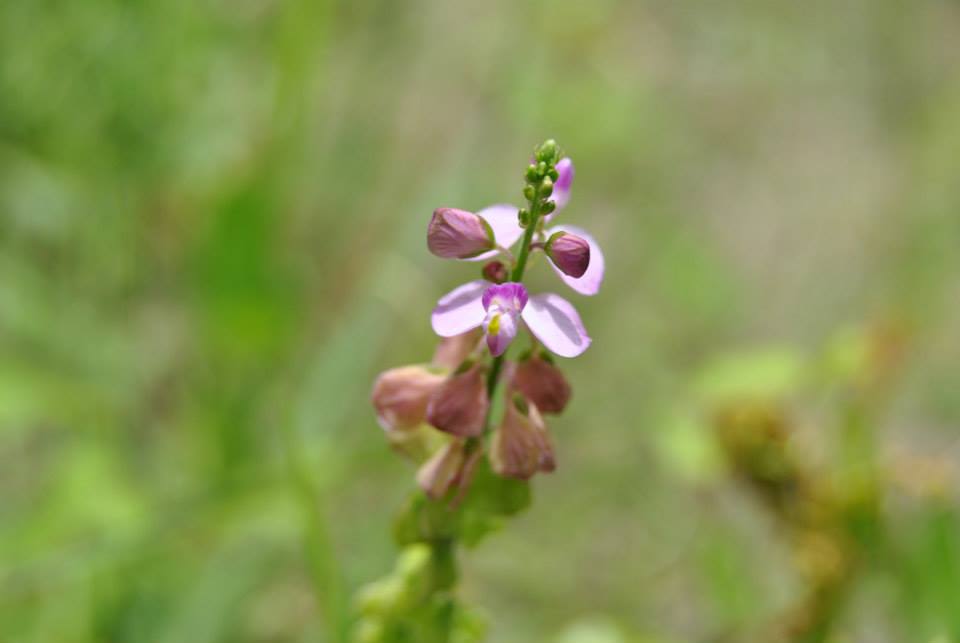Difference between revisions of "Polygala grandiflora"
Lsandstrum (talk | contribs) |
|||
| Line 30: | Line 30: | ||
==Ecology== | ==Ecology== | ||
===Habitat=== <!--Natural communities, human disturbed habitats, topography, hydrology, soils, light, fire regime requirements for removal of competition, etc.--> | ===Habitat=== <!--Natural communities, human disturbed habitats, topography, hydrology, soils, light, fire regime requirements for removal of competition, etc.--> | ||
| − | This species has been found growing within calcareous glades, upland pine woods, longleaf pine-scrub oak sand ridges, savannas, and sandhill communities (Deyrup et al 2002, FSU Herbarium). It has also been observed growing in swales of slash pine plantations (FSU Herbarium). | + | This species has been found growing within calcareous glades, upland pine woods, longleaf pine-scrub oak sand ridges, savannas, and sandhill communities (Deyrup et al 2002, FSU Herbarium). It has also been observed growing in swales of slash pine plantations (FSU Herbarium). ''P. grandiflora'' responds negatively to soil disturbance by agriculture in Southwest Georgia.<ref>Kirkman, L.K., K.L. Coffey, R.J. Mitchell, and E.B. Moser. Ground Cover Recovery Patterns and Life-History Traits: Implications for Restoration Obstacles and Opportunities in a Species-Rich Savanna. (2004). Journal of Ecology 92(3):409-421.</ref> |
===Phenology=== <!--Timing off flowering, fruiting, seed dispersal, and environmental triggers. Cite PanFlora website if appropriate: http://www.gilnelson.com/PanFlora/ --> | ===Phenology=== <!--Timing off flowering, fruiting, seed dispersal, and environmental triggers. Cite PanFlora website if appropriate: http://www.gilnelson.com/PanFlora/ --> | ||
Revision as of 19:31, 15 July 2019
| Polygala grandiflora | |
|---|---|

| |
| Photo taken by Michelle M. Smith | |
| Scientific classification | |
| Kingdom: | Plantae |
| Division: | Magnoliophyta – Flowering plants |
| Class: | Magnoliopsida – Dicotyledons |
| Order: | Polygalales |
| Family: | Polygalaceae |
| Genus: | Polygala |
| Species: | P. grandiflora |
| Binomial name | |
| Polygala grandiflora Walter | |

| |
| Natural range of Polygala grandiflora from USDA NRCS Plants Database. | |
Common name: Showy milkwort
Contents
Taxonomic notes
Description
Perennial that grows 6-12 inches in height including the elongated spike of pink or rosy flowers. Flowers average width of less than half an inch.[1]
Distribution
Ecology
Habitat
This species has been found growing within calcareous glades, upland pine woods, longleaf pine-scrub oak sand ridges, savannas, and sandhill communities (Deyrup et al 2002, FSU Herbarium). It has also been observed growing in swales of slash pine plantations (FSU Herbarium). P. grandiflora responds negatively to soil disturbance by agriculture in Southwest Georgia.[2]
Phenology
This species has been observed flowering and fruiting in May (FSU Herbarium).Cultivated plants may be in continuous bloom from earliest spring to late autumn, or even year round in southern Florida.[3]
Seed dispersal
This species is thought to be dispersed by ants and/or explosive dehiscence. [4]
Seed bank and germination
Fire ecology
Flowers within two months of burning in early summer (Robertson).
Pollination
The following Hymenoptera families and species were observed visiting flowers of Polygala grandiflora at Archbold Biological Station (Deyrup 2015):
Megachilidae: Anthidiellum notatum rufomaculatum
Use by animals
Deyrup observed this bee, Anthidiellum notatum rufimaculatum, on P. grandiflora (Deyrup et al 2002).Lilliputian moths pupa have been observed consuming the seeds inside the capsules.[5]
Diseases and parasites
Conservation and Management
Cultivation and restoration
Photo Gallery
References and notes
Deyrup, M.A. and N.D. 2015. Database of observations of Hymenoptera visitations to flowers of plants on Archbold Biological Station, Florida, USA.
Deyrup, M. J. E., and Beth Norden (2002). "The diversity and floral hosts of bees at the Archbold Biological Station, Florida (Hymenoptera: Apoidea)." Insecta mundi 16(1-3).
Florida State University Robert K. Godfrey Herbarium database. URL: http://herbarium.bio.fsu.edu. Last accessed: June 2014. Collectors: Ann F. Johnson, Wilson Baker, Roy Komarek, R. A. Norris, Robert K. Godfrey, A. Gholson Jr., Chris Cooksey, Kevin Oakes, and Lisa Keppner. States and Counties: Florida: Calhoun, Gadsden, Jackson, Leon, Sarasota, Wakulla, and Washington. Georgia: Grady and Thomas.
Robertson, Kevin M. 2014. Personal observation at Pebble Hill Plantation, Grady County, GA.
- ↑ Osorio R. 2004 The Wildflower Garden Showy Milkwort Palmetto 22(4):10-11
- ↑ Kirkman, L.K., K.L. Coffey, R.J. Mitchell, and E.B. Moser. Ground Cover Recovery Patterns and Life-History Traits: Implications for Restoration Obstacles and Opportunities in a Species-Rich Savanna. (2004). Journal of Ecology 92(3):409-421.
- ↑ Osorio R. 2004 The Wildflower Garden Showy Milkwort Palmetto 22(4):10-11
- ↑ Kirkman, L. Katherine. Unpublished database of seed dispersal mode of plants found in Coastal Plain longleaf pine-grasslands of the Jones Ecological Research Center, Georgia.
- ↑ Osorio R. 2004 The Wildflower Garden Showy Milkwort Palmetto 22(4):10-11.